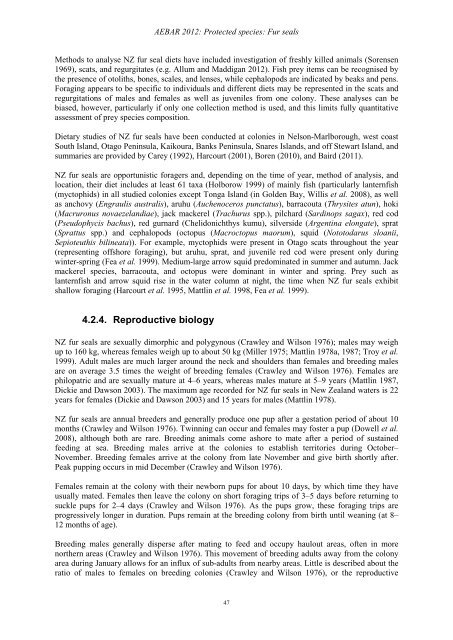Aquatic Environment and Biodiversity Annual Review 2012
Aquatic Environment and Biodiversity Annual Review 2012
Aquatic Environment and Biodiversity Annual Review 2012
Create successful ePaper yourself
Turn your PDF publications into a flip-book with our unique Google optimized e-Paper software.
AEBAR <strong>2012</strong>: Protected species: Fur seals<br />
Methods to analyse NZ fur seal diets have included investigation of freshly killed animals (Sorensen<br />
1969), scats, <strong>and</strong> regurgitates (e.g. Allum <strong>and</strong> Maddigan <strong>2012</strong>). Fish prey items can be recognised by<br />
the presence of otoliths, bones, scales, <strong>and</strong> lenses, while cephalopods are indicated by beaks <strong>and</strong> pens.<br />
Foraging appears to be specific to individuals <strong>and</strong> different diets may be represented in the scats <strong>and</strong><br />
regurgitations of males <strong>and</strong> females as well as juveniles from one colony. These analyses can be<br />
biased, however, particularly if only one collection method is used, <strong>and</strong> this limits fully quantitative<br />
assessment of prey species composition.<br />
Dietary studies of NZ fur seals have been conducted at colonies in Nelson-Marlborough, west coast<br />
South Isl<strong>and</strong>, Otago Peninsula, Kaikoura, Banks Peninsula, Snares Isl<strong>and</strong>s, <strong>and</strong> off Stewart Isl<strong>and</strong>, <strong>and</strong><br />
summaries are provided by Carey (1992), Harcourt (2001), Boren (2010), <strong>and</strong> Baird (2011).<br />
NZ fur seals are opportunistic foragers <strong>and</strong>, depending on the time of year, method of analysis, <strong>and</strong><br />
location, their diet includes at least 61 taxa (Holborow 1999) of mainly fish (particularly lanternfish<br />
(myctophids) in all studied colonies except Tonga Isl<strong>and</strong> (in Golden Bay, Willis et al. 2008), as well<br />
as anchovy (Engraulis australis), aruhu (Auchenoceros punctatus), barracouta (Thrysites atun), hoki<br />
(Macruronus novaezel<strong>and</strong>iae), jack mackerel (Trachurus spp.), pilchard (Sardinops sagax), red cod<br />
(Pseudophycis bachus), red gurnard (Chelidonichthys kumu), silverside (Argentina elongate), sprat<br />
(Sprattus spp.) <strong>and</strong> cephalopods (octopus (Macroctopus maorum), squid (Nototodarus sloanii,<br />
Sepioteuthis bilineata)). For example, myctophids were present in Otago scats throughout the year<br />
(representing offshore foraging), but aruhu, sprat, <strong>and</strong> juvenile red cod were present only during<br />
winter-spring (Fea et al. 1999). Medium-large arrow squid predominated in summer <strong>and</strong> autumn. Jack<br />
mackerel species, barracouta, <strong>and</strong> octopus were dominant in winter <strong>and</strong> spring. Prey such as<br />
lanternfish <strong>and</strong> arrow squid rise in the water column at night, the time when NZ fur seals exhibit<br />
shallow foraging (Harcourt et al. 1995, Mattlin et al. 1998, Fea et al. 1999).<br />
4.2.4. Reproductive biology<br />
NZ fur seals are sexually dimorphic <strong>and</strong> polygynous (Crawley <strong>and</strong> Wilson 1976); males may weigh<br />
up to 160 kg, whereas females weigh up to about 50 kg (Miller 1975; Mattlin 1978a, 1987; Troy et al.<br />
1999). Adult males are much larger around the neck <strong>and</strong> shoulders than females <strong>and</strong> breeding males<br />
are on average 3.5 times the weight of breeding females (Crawley <strong>and</strong> Wilson 1976). Females are<br />
philopatric <strong>and</strong> are sexually mature at 4–6 years, whereas males mature at 5–9 years (Mattlin 1987,<br />
Dickie <strong>and</strong> Dawson 2003). The maximum age recorded for NZ fur seals in New Zeal<strong>and</strong> waters is 22<br />
years for females (Dickie <strong>and</strong> Dawson 2003) <strong>and</strong> 15 years for males (Mattlin 1978).<br />
NZ fur seals are annual breeders <strong>and</strong> generally produce one pup after a gestation period of about 10<br />
months (Crawley <strong>and</strong> Wilson 1976). Twinning can occur <strong>and</strong> females may foster a pup (Dowell et al.<br />
2008), although both are rare. Breeding animals come ashore to mate after a period of sustained<br />
feeding at sea. Breeding males arrive at the colonies to establish territories during October–<br />
November. Breeding females arrive at the colony from late November <strong>and</strong> give birth shortly after.<br />
Peak pupping occurs in mid December (Crawley <strong>and</strong> Wilson 1976).<br />
Females remain at the colony with their newborn pups for about 10 days, by which time they have<br />
usually mated. Females then leave the colony on short foraging trips of 3–5 days before returning to<br />
suckle pups for 2–4 days (Crawley <strong>and</strong> Wilson 1976). As the pups grow, these foraging trips are<br />
progressively longer in duration. Pups remain at the breeding colony from birth until weaning (at 8–<br />
12 months of age).<br />
Breeding males generally disperse after mating to feed <strong>and</strong> occupy haulout areas, often in more<br />
northern areas (Crawley <strong>and</strong> Wilson 1976). This movement of breeding adults away from the colony<br />
area during January allows for an influx of sub-adults from nearby areas. Little is described about the<br />
ratio of males to females on breeding colonies (Crawley <strong>and</strong> Wilson 1976), or the reproductive<br />
47

















